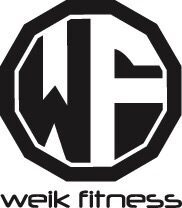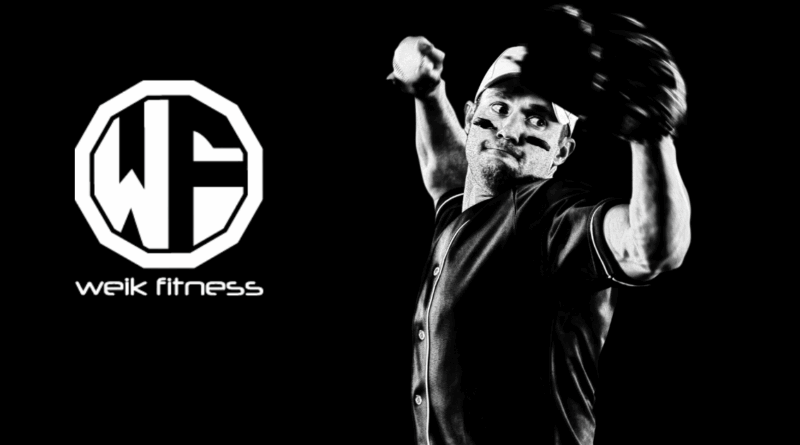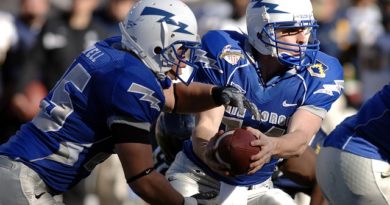How To Improve Baseball Arm Recovery and Pitcher Arm Care
Soreness after a game can feel scary. A solid arm care routine lowers risk, cuts pain, and builds confidence. A baseball and softball player needs to create an arm care routine to take care of your arm. Baseball arm recovery protocols are essential for health and performance.
There is no “one thing” that is going to be the end-all, be-all solution here. You’re going to think along the lines of arm care exercises, training programs, and strengthening exercises (exercise routine for overall health), active recovery, workload management, the list goes on and on.
It may seem overwhelming, but that’s where our guide comes in. We’ll look at all the stress on the arm that takes place from the pitching motion, recovery methods, proper mechanics, strength and conditioning, and put it all together in a comprehensive arm care program.
As a youth baseball coach, certified strength coach, and sports nutritionist, I’ve worked with clients from the high school level all the way up to my clients in MLB. Your arm is your most valuable asset as a pitcher, and you need to have an arm care routine that is specific to your needs.
RELATED: How To Increase Baseball Throwing Speed and Pitch Velocity
We are going to take the guesswork out of recovery for pitchers to promote optimal recovery. Use the simple steps below for better baseball arm recovery, steadier velocity, and a healthier elbow and shoulder.
Table of contents
- Key Principles of Baseball Arm Recovery and Pitcher Arm Care
- Steps for Immediate Baseball Arm Recovery After Pitching
- Strategies for Prolonged Arm Strength and Recovery in Baseball Pitching
- Establishing a Comprehensive Baseball Arm Care Routine for Pitchers
- Tools and Drills for Effective Baseball Arm Recovery and Pitcher Arm Care
- Arm Care Considerations for Youth Baseball Pitchers
- Maintain Peak Performance Through Baseball Arm Recovery and Pitcher Arm Care
- Baseball Arm Recovery FAQs
- Pitcher Arm Care References
Key Takeaways
- Youth pitchers ages 9–14 should cap daily throws at 85 pitches. Ages 15–18 should stay under 95.
- Group-based arm care programs with resistance bands can halve elbow injury risk.
- Plan one or two full rest days each week for real healing.
- Post-pitching recovery works best with light cardio, 18–20 second static stretches, and foam rolling.
- Use heat before workouts. Ice only for acute injuries or swelling.
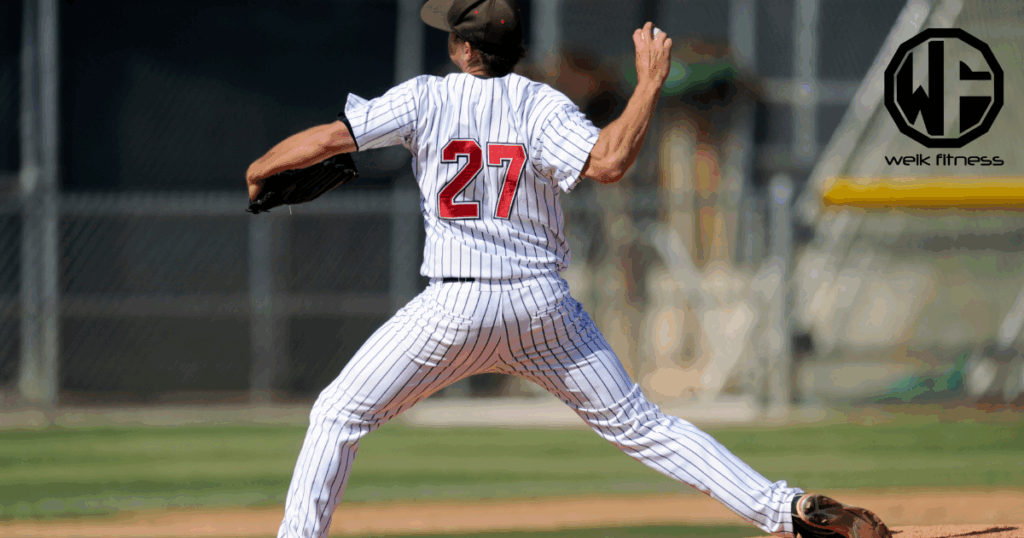
Key Principles of Baseball Arm Recovery and Pitcher Arm Care
Smart recovery is a habit, not a single fix. Focus on blood flow, safe range of motion, and injury prevention. These basics protect your pitching arm through a long season.
How can I prevent overuse arm injuries with proper pitcher arm care?
Start every session with a dynamic warm-up.
Dynamic means moving stretches, like arm swings and leg swings. Add band work to activate the rotator cuff and shoulder blade muscles. This boosts blood flow and prepares tissue for stress.
Follow pitch count guidelines. Build throws over four to six weeks, not overnight.
Group arm care sessions, especially with bands, can cut elbow injuries by about half. Pay attention to pain and heavy fatigue. Those are signs to rest.
Train your whole body, not only your arms. Strong legs and core reduce strain on the arm.
How does strategic recovery boost long-term pitching performance?
Continuous strain on your arm can sideline you and have you riding the pine. That’s not something any pitcher or player wants to have happen.
Recovery rebuilds what pitching breaks down. Too many pitches or poor rest raises injury risk and can slow the ball. Plan strict pitch counts and use scheduled rest days. Warm up dynamically to drive blood flow. Finish with cool-down stretches to keep joints moving well.
Top pitchers blend mobility and muscle activation in daily routines.
Light cardio, gentle stretching, and tools like foam rollers support repair between outings. Heat can loosen tissue before workouts, while ice is best for new swelling. Put these pieces together, and your performance holds longer through the season.
Steps for Immediate Baseball Arm Recovery After Pitching
The first 20 minutes after you throw influence tomorrow. Use light movement to push fresh blood through tired muscles. Then restore mobility with simple stretches and soft tissue work.
What light cardio exercises improve blood flow after pitching?
- Walk briskly for 10–15 minutes. This pumps blood and speeds repair.
- Ride a bike with low resistance for 8–12 minutes. Legs work, shoulders relax.
- Swim easy laps for 5–10 minutes. Water reduces joint stress while you move.
- Jump rope lightly for 3–5 minutes. Choose slow, steady jumps.
- Row on a machine for 6–8 minutes. Keep elbows close and motion smooth.
- March in place or do high-knee walks for 8 minutes. Simple and effective.
- Use rebounders for 10 controlled reps. Train safe force absorption at the elbow and shoulder.
These options fit into most recovery routines and take little time. Use one or two after every outing. You will feel looser, and recovery time often improves.
How do static stretches increase flexibility and relax pitching muscles?
Static stretches are held positions, not bouncing moves. They calm the nervous system, lengthen tissue, and help restore range of motion after intense work.
- Target shoulder and triceps to reduce tightness in the throwing arm.
- Stretching improves blood flow, which may clear fatigue chemicals faster.
- Hold each stretch 18–20 seconds. Repeat three times per muscle group.
- Use a cross-body shoulder stretch to restore internal rotation that often drops after pitching.
- Better flexibility lowers strain from repeated pitching mechanics.
- Pitchers who stretch consistently stay mobile deeper into the season.
- Protect the rotator cuff by stretching the muscles that support it.
- Stretch after light cardio to improve results and relax faster.
- Prime tissue with bands or a foam roller before stretching to warm it.
- Make stretching a non-negotiable step after every throwing session.
Which foam roller and massage gun techniques aid baseball arm recovery?
Soft tissue tools help break up tight spots. They also improve circulation and reduce soreness after throwing.
- Use a foam roller for five minutes after games or practice.
- Roll slowly over forearms, deltoids, and triceps. Pause on tight spots.
- Try a massage stick for better control on smaller areas.
- Use a massage gun like the TheraGun Therabody on low speed before you throw. Switch to higher settings after throwing for deeper release.
- Choose attachments wisely. Bullet heads for small points, flat heads for larger areas.
- Work these tools three to five times a week for 10–15 minutes.
- Avoid pressing hard on bones. Too much force can bruise tissue.
- Hydrate before and after. Water helps flush waste from sore muscles.
Combine these strategies with stretching. Your arm will feel better and stay ready for the next outing.
How should I use ice and heat to manage inflammation and maintain mobility?
Inflammation is part of healing. Your job is to manage it, not erase it.
- Use heat packs before throwing or training to loosen tissue and increase blood flow.
- After pitching, choose gentle movement over sitting with ice. Walk, stretch, or use a muscle stim device to increase circulation.
- Use ice for new impact injuries or clear swelling, not every day.
- Avoid overusing NSAIDs. Too much can limit normal repair.
- Keep mobility with light band work and cross-body stretches after pitching.
- Use heat on recovery days to improve flexibility, especially before stretching.
- Prioritize sleep, hydration, and smart food choices. These basics matter most.
Strategies for Prolonged Arm Strength and Recovery in Baseball Pitching
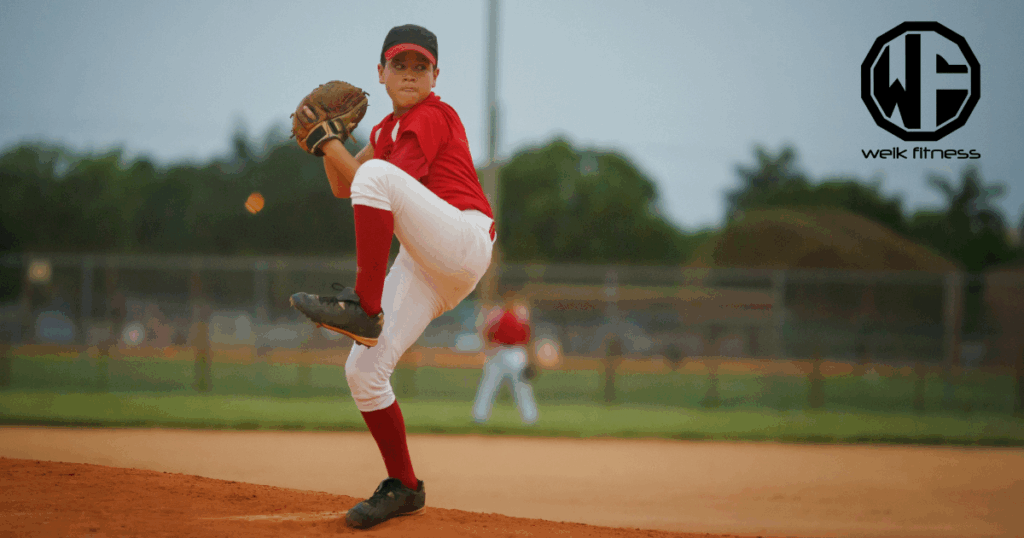
Long-term arm health depends on smart workload choices. Follow pitch count rules, train the rotator cuff, and schedule rest. See the rotator cuff strengthening resource for ideas you can use.
Why is following pitch count guidelines and rest days important?
Pitch counts protect growing joints. Ages 9 to 14 should stop at 85 pitches a day. Ages 15 to 18 should stop at 95. For younger kids, limiting pitches beats limiting innings.
Rest days matter as much as the limit itself. Plan one or two full days off from pitching each week. Track every outing on a chart. Consistent limits reduce elbow pain and protect your future, season after season.
How can I strengthen the rotator cuff and supporting muscles effectively?
The rotator cuff is a group of four small shoulder muscles. They center the ball in the socket during throwing. Strong cuff muscles protect the joint and help decelerate the arm.
Start with light band external rotations and abductions. Move slow and control the motion. Add prone Y-raises or sidelying raises to target the supraspinatus. Include scapular control drills, like wall slides, to steady the shoulder blade. Adjust exercises based on soreness, pitch counts, and recent workload. Progress the plan over weeks, not days.
How do I recognize, respond, and monitor arm to soreness and fatigue?
Up to half of young pitchers report arm pain. Watch for soreness that lingers into the next day or loss of shoulder motion. These can signal overuse or changes in mechanics. If throws feel weak or timing feels off, fatigue is building.
Respond early. Cut back on throwing for a few days. Keep blood moving with easy biking or walking. Use static stretches to calm tight areas. Foam roll your upper back and shoulder blade region.
Ice can help swelling. Heat can loosen stiffness.
If pain is sharp or strength drops fast, talk to a licensed athletic trainer, physical therapist, or sports medicine doctor.
Establishing a Comprehensive Baseball Arm Care Routine for Pitchers
A consistent routine helps you throw with less pain and more command. Use foam rollers, bands, and focused rotator cuff exercises. This structure supports rest and recovery between games.
What are essential warm-up exercises before pitching?
A complete warm-up takes about 20 to 25 minutes. Prepare your body and mind before you step on the mound.
- Start with slow breathing resets to improve posture and focus.
- Use a foam roller on arms, shoulders, and back for 30 seconds in each area.
- Do dynamic mobility, like arm circles and shoulder sweeps.
- Activate with pitching bands, such as Jaeger Bands or crossover bands.
- Add lower-body prep, like lateral band walks and hip mobility moves.
- Perform a few reverse throws with light weights or a med ball for trunk stability.
- Finish with light dumbbell external rotations to prep the decelerators.
Run this warm-up before every bullpen or game. Small daily wins add up to long-term arm health.
How should I cool down after pitching to protect my arm?
A good cool-down lowers stiffness and helps you feel ready for the next outing.
- Use active mobility for shoulders and wrists to keep joints loose.
- Walk or jog lightly for 5–10 minutes to improve blood flow.
- Apply static stretches to shoulders, back, and forearms.
- Include deceleration and posterior cuff activation drills.
- Use a foam roller or massage gun on lats, upper back, and triceps for 1–2 minutes each.
- Add compression with a wrap or sleeve to limit minor swelling.
- Ice only if you notice pain or visible inflammation.
- Use heat before deeper stretching if tissues feel stiff.
- Breathe slowly during stretches to relax the whole body.
- Log how your arm feels after each session to monitor trends.
Many pages of free baseball instruction emphasize cool-downs for good reason. Consistent recovery habits protect performance and keep you on the field.
Tools and Drills for Effective Baseball Arm Recovery and Pitcher Arm Care
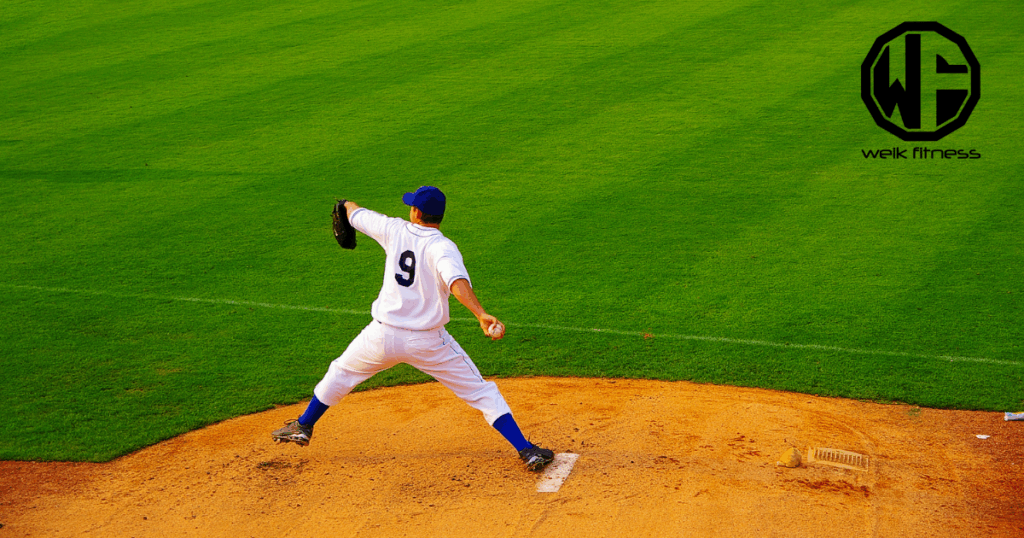
Simple tools create big gains over time. Resistance bands and cross-body stretches support stability, improve shoulder motion, and help you stay game-ready.
How do resistance bands improve shoulder stability for pitchers?
- Bands strengthen muscles around the shoulder, elbow, and forearm.
- They improve flexibility and range of motion for smoother throws.
- Band pull-aparts help reset normal shoulder blade movement after pitching.
- No Money drills train the external rotators, easing deltoid overload.
- Training small stabilizers supports injury prevention in your routine for pitchers.
- Many pros use bands to fine-tune mechanics and reduce joint stress.
- Ask a coach or physical therapist for safe progressions.
- Regular use often leaves arms less stiff after bullpens.
- Bands are portable, perfect for travel days and tournaments.
Make bands part of your health and recovery plan. The shoulder will feel steadier through long stretches of games.
What exercises best strengthen the rotator cuff?
Build strength and control together. Healthy tendons need both.
- Do band external rotations with the elbow at 90 degrees.
- Add internal rotations for balanced front and back strength.
- Use slow eccentric lowerings on band or cable rotations.
- Try rhythmic stabilization with a partner tapping while you hold steady.
- Train shoulder blade stability with rows and band pull-aparts.
- Hold the arm at 90 degrees overhead with light loads to mimic throwing.
- Screen shoulder strength often to catch tightness or weak links.
- Use cross-body stretches daily to keep internal rotation.
- Match exercises to your schedule and workload with guidance from a trainer.
- Reduce intensity if soreness rises. Keep progress steady and safe.
How do cross-body stretches enhance shoulder flexibility?
Cross-body stretches target the back of the shoulder. That area tightens after tough throwing days.
- They reduce posterior shoulder tightness after games or bullpens.
- They help restore the common 10-degree drop in internal rotation.
- They support shoulder blade stability during fast throws.
- Coaches report fewer injuries when these stretches are part of a plan.
- Hold each side-lying cross-body stretch for 5–10 seconds to start.
- Regular use improves range of motion and smoother throwing.
- They reduce compensations that stress the arm during hard innings.
- Foam rollers or massage guns before or after can boost results.
- Many players add a light band to the stretch for a gentle cue.
- They fit any arm care routine and take only a few minutes.
Arm Care Considerations for Youth Baseball Pitchers
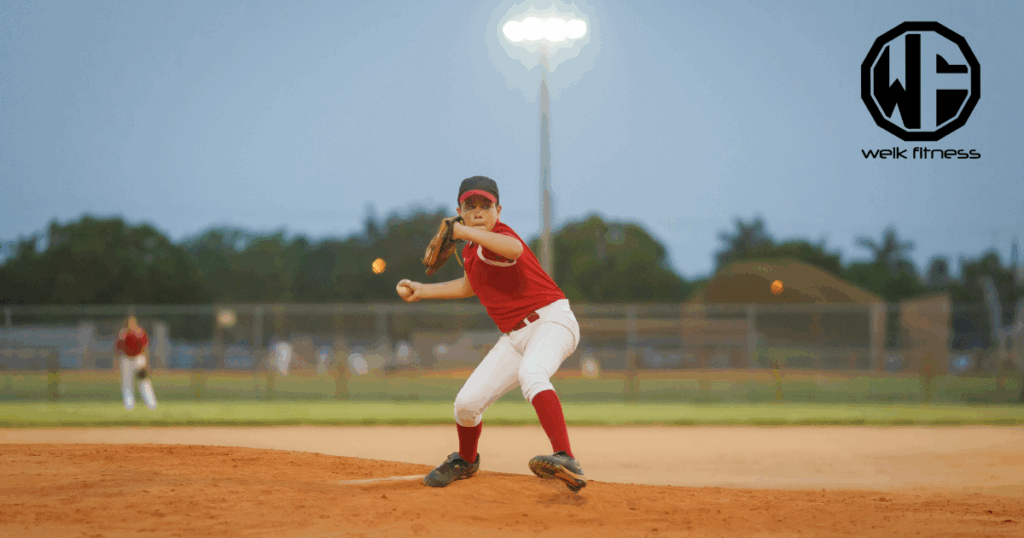
Protect young arms with smart limits and simple strength work. Good habits now support healthy growth and a longer baseball journey.
How should pitch counts be set for young baseball players?
Track every pitch. Ages 9 to 14 should throw no more than 85 per day. Ages 15 to 18 should cap at 95. Kids 9 to 12 often need even lower totals. Coaches must log pitch counts every game.
Plan one or two weekly rest days from pitching. After three straight days of throwing, make the next day a no-throw day. These USA Baseball guidelines help lower injury risk and protect the elbow and shoulder.
What age-appropriate exercises and techniques should youth pitchers use?
Use J-Bands for arm care. They cost about $35 and include an 11-exercise sheet from Jaeger Sports. Complete 10 to 12 reps of each movement before practice. After throwing, do 25 external rotations.
Try long toss two or three days a week, never back-to-back. Learn the difference between soreness and pain. Stop throwing if something hurts. Limit curveballs, one or two an inning, and build fastball command and changeups first.
Use smartphone video, like Coach’s Eye or Hudl, to check mechanics at slow speed. Keep bullpens focused on form between ages 11 and 14. Safe habits now lead to stronger, safer pitching later.
Maintain Peak Performance Through Baseball Arm Recovery and Pitcher Arm Care
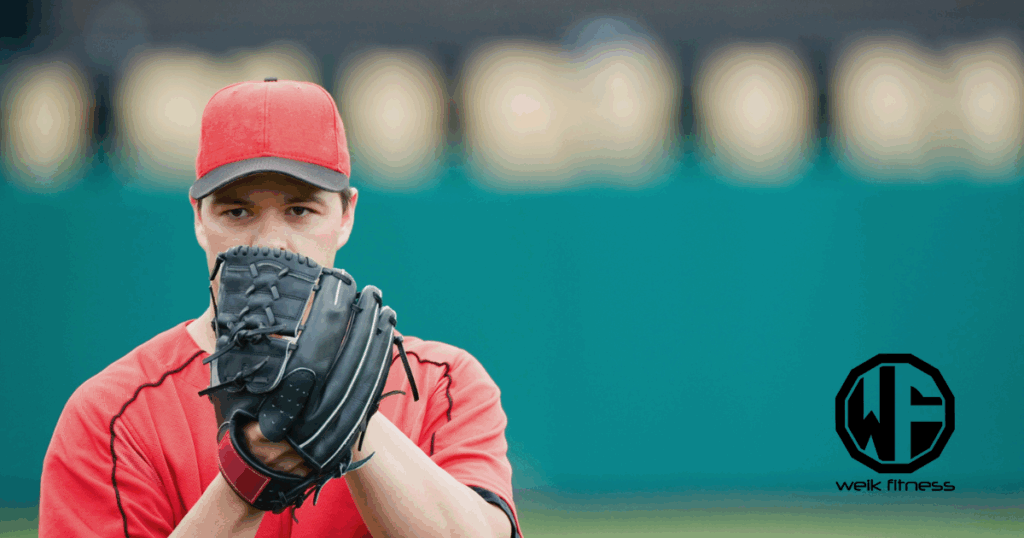
Strong pitcher arm care supports steady velocity and fewer arm injuries. Build a reliable post-pitching arm care routine with light cardio, static stretching, foam rolling, and smart ice or heat use. Follow pitch count rules and schedule rest days to protect your throwing arm through the season.
Use resistance bands for shoulder stability and keep up with rotator cuff exercises. If pain is sharp, swelling increases, or function drops, see a licensed athletic trainer, physical therapist, or sports medicine doctor.
Commit to your plan each week. You set yourself up for faster recovery, less soreness, and better pitching performance across every inning.
Baseball Arm Recovery FAQs
Proper arm care starts with gentle stretching and light movement to keep blood flowing. Use ice packs if soreness appears, but avoid overusing them. Hydrate well and eat foods that help muscle repair. These habits support strong recovery.
Rest is key; give your muscles time to heal between throwing sessions. Focus on low-impact activities like walking or cycling to maintain fitness while reducing strain on your pitching arm. Listen closely to pain signals—never push through sharp discomfort.
Strengthen shoulder, back, and core muscles using resistance bands or bodyweight moves such as planks and rows. Controlled movements build stability around the joint, which helps prevent injuries during intense play.
Regular routines protect against overuse problems common in baseball players who pitch often. Monitoring how your arm feels each day lets you spot warning signs early, so you can adjust training before small issues become serious setbacks… keeping you ready for every inning ahead!
Pitcher Arm Care References
- https://sparkptnc.com/arm-care/
- https://mvpbattingcages.com/baseball-pitching-arm-care/
- https://www.kpimh.com/blog/arm-care-routine/
- https://www.baseballmonkey.com/learn/pitching-arm-care
- https://blog.armcare.com/ice-post-pitching/
- https://pmc.ncbi.nlm.nih.gov/articles/PMC7983445/
- https://pmc.ncbi.nlm.nih.gov/articles/PMC7990975/
- https://inmotionptny.com/baseball-arm-care-pre-season-training-guide-for-pitchers-and-players/
- https://oatesspecialties.com/blogs/default-blog/the-ultimate-guide-to-baseball-arm-care-a-simple-science-backed-approach
- https://rocklandpeakperformance.com/arm-care-for-pitchers-warmup-routine/
- https://earlyworktraining.com/arm-strength-exercises-baseball/
- https://www.ptgamechanger.com/blog/arm-care-after-pitching
- https://www.road2gameday.com/a-parents-guide-to-youth-pitching-and-arm-care/


*Disclosure: This article may contain affiliate links or ads, which means we earn a small commission at no extra cost to you if you make a purchase through these links. These commissions help support the operation and maintenance of our website, allowing us to continue producing free valuable content. Your support is genuinely appreciated, whether you choose to use our links or not. Thank you for being a part of our community and enjoying our content.
PLEASE CONSIDER SHARING THIS ON YOUR SOCIAL MEDIA TO HELP OTHERS LEARN MORE ABOUT THIS TOPIC.
